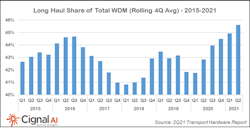Optical transport spending drops in 2Q21 but North American rebound expected: Cignal AI
Global spending on optical transport equipment dropped 5% in the second quarter of 2021, Cignal AI states. Weakness in North America and what the market research firm termed a “collapse” in China offset a strong quarter in Europe. However, the outlook in North America should brighten in the second half of the year, the market research firm states in its latest Transport Hardware Report.
Cignal AI lays the North American troubles from a year-to-year perspective at the feet of cyclical pandemic influences in 2020. Meanwhile, the 20% decline in Chinese spending during the quarter resulted from a pause in 5G capex outlays and an increase in supply chain issues, the analysts say. These factors led to what Cignal AI reports is the largest single quarterly decline they’ve recorded and the first time the Chinese market has seen consecutive quarters with year-over-year declines.
Vendors are more likely to enjoy a reversal of fortunes in North America, Cignal AI believes. “Despite current semiconductor supply chain issues, North American spending should accelerate in the second half of 2021 as operators purchase additional high-performance long-haul WDM coherent equipment,” said Kyle Hollasch, lead analyst for transport hardware at Cignal AI. “Long-haul line systems capable of supporting wider and variable channel spacing, higher degree counts, and improved add/drop capabilities provide compelling reasons to make investments now.”
Such long-haul systems already show increased popularity compared to other application types. Long-haul WDM gear spending eclipsed that of metro systems at a record level during the second quarter of 2021, capping five quarters of investment in advanced coherent and line system technology (see chart above). Cignal AI theorizes that communications services providers may be waiting for full availability of 400G coherent pluggable modules before they embark on a new round of metro WDM upgrades.
Meanwhile, second quarter sales of optical network platforms climbed significantly year-to-year in Europe, the Middle East, and Africa (EMEA), a region that has settled into a consistent single-digit growth phase, according to the report. While Nokia and Ciena say they’ve reaped the benefits of operators’ desire to replace Huawei equipment, Cignal AI says this trend has yet to put a significant dent in Huawei’s EMEA market share.
Finally, the impact of component shortages is beginning to appear. While some of the larger vendors have so far claimed immunity from the challenge, other such as ADVA and Infinera state that such shortages have affected revenues by 10% and 6%, respectively. Cignal AI reports that consensus among suppliers is that such shortages won’t be resolved until sometime next year.
Cignal AI’s quarterly Transport Hardware Report covers optical and packet transport equipment revenue across all regions and equipment types. The initial analysis is based on financial results, independent research, and guidance from individual equipment companies. Hardware forecasts are reviewed and updated in the following weeks, along with spending trends by operator type. The Transport Hardware Report examines revenue for metro WDM, long-haul WDM, and submarine (SLTE) optical equipment, and access, aggregation, edge, and core packet equipment in six global regions.
For related articles, visit the Business Topic Center.
For more information on high-speed transmission systems and suppliers, visit the Lightwave Buyer’s Guide.
To stay abreast of fiber network deployments, subscribe to Lightwave’s Service Providers and Datacom/Data Center newsletters.
About the Author

Stephen Hardy
Editorial Director and Associate Publisher, Lightwave
Stephen Hardy is editorial director and associate publisher of Lightwave and Broadband Technology Report, part of the Lighting & Technology Group at Endeavor Business Media. Stephen is responsible for establishing and executing editorial strategy across the both brands’ websites, email newsletters, events, and other information products. He has covered the fiber-optics space for more than 20 years, and communications and technology for more than 35 years. During his tenure, Lightwave has received awards from Folio: and the American Society of Business Press Editors (ASBPE) for editorial excellence. Prior to joining Lightwave in 1997, Stephen worked for Telecommunications magazine and the Journal of Electronic Defense.
Stephen has moderated panels at numerous events, including the Optica Executive Forum, ECOC, and SCTE Cable-Tec Expo. He also is program director for the Lightwave Innovation Reviews and the Diamond Technology Reviews.
He has written numerous articles in all aspects of optical communications and fiber-optic networks, including fiber to the home (FTTH), PON, optical components, DWDM, fiber cables, packet optical transport, optical transceivers, lasers, fiber optic testing, and more.
You can connect with Stephen on LinkedIn as well as Twitter.
